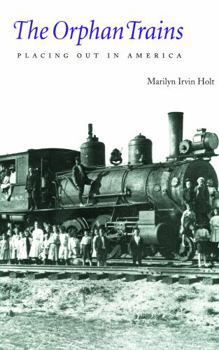The Orphan Trains: Placing Out in America
Select Format
Select Condition 
Book Overview
"From 1850 to 1930 America witnessed a unique emigration and resettlement of at least 200,000 children and several thousand adults, primarily from the East Coast to the West. This 'placing out, ' an... This description may be from another edition of this product.
Format:Paperback
Language:English
ISBN:0803272650
ISBN13:9780803272651
Release Date:February 1994
Publisher:Bison Books
Length:264 Pages
Weight:0.20 lbs.
Dimensions:0.6" x 8.1" x 8.3"
Customer Reviews
4 ratings
interesting history, more of a textbook
Published by Thriftbooks.com User , 14 years ago
This is another interesting book about a sad part of our history. It just doesn't tell about the Orphan trains, it also explains the attitudes about childhood, poverty and society at that time. It reads more like a textbook though, I felt I should be highlighting topics for class.
Orphan Trains is a Fascinating Account
Published by Thriftbooks.com User , 15 years ago
The Orphan Trains, by Marilyn Irvin Holt, is simply excellent. The book is extremely well-written and absolutely riveting. Holt carefully documents her work. I particularly enjoyed the author's discussion of how child rearing views were changing during this time in American history. It was fascinating to read because it clearly paves the way for why the "placing out" of these children was seen as such an excellent idea. Shipping these children off to other parts of the country seemed completely justifiable when one considers the alternative facing these children. Indeed, the idea of "placing out" isn't so bad considering what happens to so many young children now raised in poverty in the ghettos of this nation. The United States was not the first country to come up with the idea of placing out. Holt points out that other countries also used this idea for "getting rid" of the impoverished. In this country, however, placing out definitely was a movement that started with well meaning motives. The idea was to salvage these often abandoned, neglected impoverished children and send them to good homes in the West where, coincidentally, their labor was also often needed. Holt's discussion of this event is just extremely well presented. She is factual and not judgmental. I'd highly recommend this book to anyone who's interested in societal changes. From this episode in history came the beginnings of social work. It also raises interesting questions about how children are dealt with nowadays where they are often left with birth parents to the extreme detriment of the child. It makes placing out seem rather desirable.
Excellent Reference Book!
Published by Thriftbooks.com User , 15 years ago
This, in my opinion, is the best reference book on the Orphan Train Movement of 1854-1929 that is available. As the granddaughter of a rider and author of 2 books on the subject, I am often asked to speak on the topic locally. I have used this book extensively in my research on this period of history. I am especially pleased that the author puts the events of the orphan train movement in context of what was going on in our country during this time allowing the reader to gain a better understanding of how and why this could have happened and why it came to an end after 75 years. Highly recommended!
An Excellent Resource!
Published by Thriftbooks.com User , 24 years ago
From 1853 to about 1929, more than 200,000 children and several thousand adults were sent west on "orphan trains," leaving crowded urban areas on the East Coast behind. Holt's book focuses on the placing out system--from its creation to its demise--instituted by the Children's Aid Society of New York. Estimates of the number of destitute children living in the streets of New York in 1853 ranged from 10,000 to more than 30,000. Charles Loring Brace, who became secretary of The Children's Aid Society believed there was no better place for vagrant or outcast children than "the farmer's home." Placing out removed destitute children from the streets of New York City, placing them with families in the west. The system was intended to provide Christian homes and families for orphaned or abandoned children while fulfilling the demand for workers on farms in America's heartland. The author also discusses other charitable organizations that imitated Children's Aid Society initiatives. She uses oral histories, institutional records, and newspaper accounts to bring the orphan train era to life in this balanced account, highlighting both the positive and negative aspects of the placing out system. Her discussion of social and economic structures of the 19th century help readers view the topic in context. This is a "must read" for anyone conducting further research in the topic, or readers who are simply interested in this lost chapter of American history.




